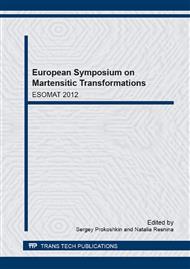[1]
M. Yaso, "Traditional Japanese Steel, Wakoh by ancient steelmaking process, TATARA and Japanese Sword", Proc.16th International Wood Machining Seminar-Aug. 24-30 (2003), Matsue, Japan pp.3-13
Google Scholar
[2]
S. Takaiwa, Y. Yoshihara, Leon and Hiroko Kapp, "The Art of Japanese Sword Polishing" Koudansha International (2006) pp.11-37
Google Scholar
[3]
S.Yamamoto, " Ancient Japanese Steelmaking Process", Tetsu-to-Hagane Overseas 1 (1961) pp.49-54
Google Scholar
[4]
K. Kiyonaga, "Tatara Steelmaking and its Metallurgy", Materia Japan 33(1994) pp.1453-1458 (in Japanese)
DOI: 10.2320/materia.33.1453
Google Scholar
[5]
K. Tawara, "Nihontoh no kagakuteki kenkyu" Hitachi Hyouronsha (1953) pp.6-77 (in Japanese)
Google Scholar
[6]
T. Takahashi, T. Murakami, S. Okada and N.Fujii, Testu-to-Hagane 71(1985) pp.108-114 (in Japanese)
Google Scholar
[7]
M. Yaso, T. Takaiwa, Y. Minagi, K. Kubota, S. Morito, T. Ohba and A. K. Das, "Study of microstructure on cross section of Japanese sword", DOI: 10.1051/esomat/2009718 pp.1-5
DOI: 10.1051/esomat/200907018
Google Scholar
[8]
T. Maki, K. Tsuzaki and I. Tamura, "The Morphology of Microstructure Composed of Lath Martensites in Steels", Transactions ISIJ, 20 (1980) pp.207-214
DOI: 10.2355/isijinternational1966.20.207
Google Scholar
[9]
A. K. Das, T. Ohba, S. Morito, G. Takami, T. Fujikawa, M. Yaso, "Characteristic Feature Found in Typical TATARA Product, Japanese Sword", Proceeding of ESOMT 2009, p.02024, DOI;
DOI: 10.1051/esomat/200902024
Google Scholar
[10]
A. K. Das, Takuya Ohba, Shigekazu Morito and Muneo Yaso, Materials Science Forum Vols. 654-656(2010) pp.138-141
DOI: 10.4028/www.scientific.net/MSF.654-656.138
Google Scholar
[11]
S. Chatterjee and H. K. D. H. Bhadeshia, "TRIP-assisted steels: cracking of high-carbon martensite", Materials Science and Technology 22(2006)6, pp.645-649
DOI: 10.1179/174328406x86182
Google Scholar
[12]
Go Takami, Takuya Ohba, Shigekazu Morito, Ananda Kumar Das, Materials Science Forum Vols. 654-656 (2010) pp.134-137
DOI: 10.4028/www.scientific.net/MSF.654-656.134
Google Scholar
[13]
M. Yaso, T. Takaiwa, Y. Minagi, T Kanaizumi, K. Kubota, T Hayashi, S. Morito and T. Ohba, "Study of Japanese sword from a viewpoint of steel strength", DOI: 10.1016/j.jalcom.2012.06/141for 2011 ISOMAT
DOI: 10.1016/j.jallcom.2012.06.141
Google Scholar
[14]
A. K. Das, T. Ohba, S. Morito, Abstract of Annual Fall Meeting of Japan Institute of Metals, 2010, Hokkaido University, p.182
Google Scholar
[15]
S. Timoshenko, Strength of material, Translator: T. Udoguchi, and T. Kunio, Part1: Elementary Theory and Problems Third Edition, (1957) Tokyo Tosho Kabushiki Kaisha 67-131 (in Japanese)
Google Scholar
[16]
O. Grinder, "PM Production and Application of HSS", http://hssforum.com/, 1st International HSS FORUM Conference, February 2-3, (2005) Aachen, German
Google Scholar


